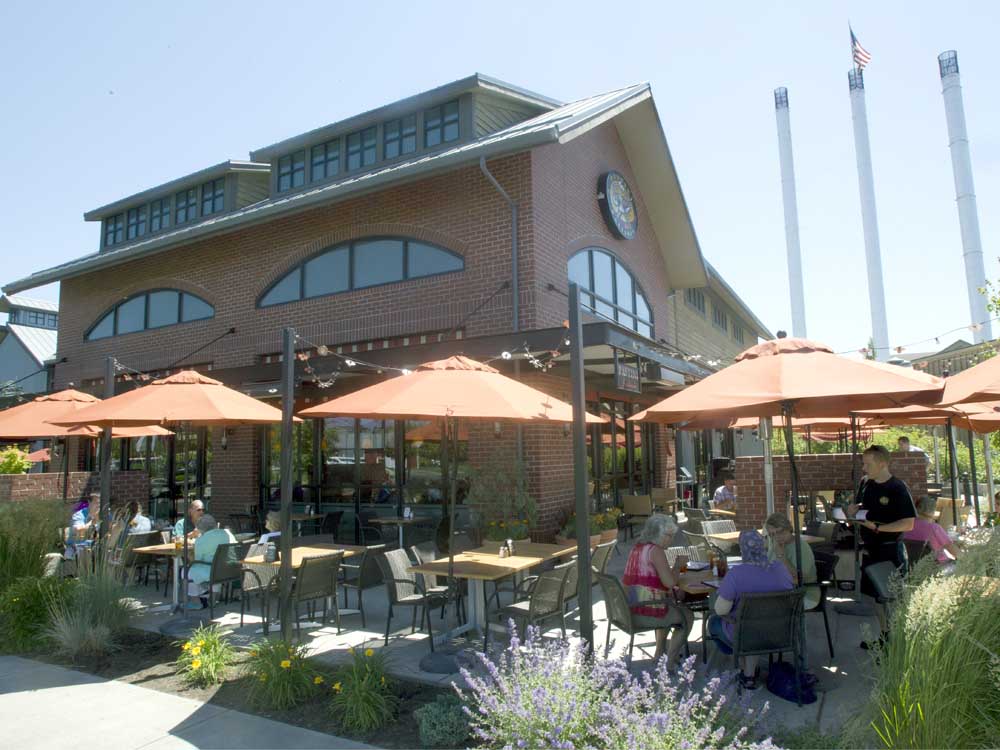Eating Italian in the Old Mill
Published 12:00 am Friday, July 3, 2015

- Photos by Andy Tullis / The BulletinPastini Pastaria server Caleb Krueger, standing on the right, takes lunch orders at the Old Mill restaurant.
Diners who love Italian food have two restaurant choices in Bend’s Old Mill District. Pastini Pastaria and Flatbread Community Oven stand side-by-side next to the Deschutes River on the north side of the shopping-and-entertainment district.
But I’m not a big fan of either one. Others may applaud the paper-thin crust of Flatbread’s Neapolitan-style pizza, and the Portland-made pastas of Pastini. I find them to be reflective of the corporate style of business in their lack of originality.
Trending
Both restaurants were established in 2008 as the first Bend franchises of regional companies. Flatbread, headquartered in Boise, has five locations, including in Bend and Salt Lake City. Portland-based Pastini has eight restaurants, with Bend and Corvallis being the only two outside of the Portland metropolitan area.
Both Old Mill facilities are handsome restaurants. The focal point at Flatbread is a domed, wood-burning oven, where pizzas are baked in 800-degree heat (the temperature rises to 1,000 degrees in the dome) on apple and maple woods. Two levels of seating surround a beautiful gas fireplace set into a brick wall adorned with candles.
Pastini is stylish and contemporary, with two walls of windows facing the Deschutes from its spacious dining room; drum-like pendant lights hang above a double tier of semi-private booths. Service at both restaurants is prompt and friendly.
Flatbread pizza
Flatbread’s specialty is pizza; specifically, pizza as it is made in the southern Italian city of Naples. The Associazione Verace Pizza Napoletana (Association for Genuine Neapolitan Pizza, or AVPN) sets out strict guidelines as to what ingredients and preparation methods may be considered authentic. Of the 535 AVPN members in 29 countries worldwide, 78 are in the United States, and only two are in Oregon (in Bend and Eugene).
At its U.S. headquarters in Marina del Rey, California, the association trains kitchen staff to mix dough rather than to toss it, and not to add tomato purée until the dough has finished baking.
Trending
According to Flatbread’s menu, eight pizzas adhere to guidelines and tradition. I tried the Diavola ($15.50), made with fior di latte mozzarella, San Marzano Pomodoro tomatoes and a spicy salami called Creminelli calabrese. Fresh basil and garlic, along with crushed red pepper, were added for flavor.
And that flavor was pretty good. But the combination of an exceedingly thin crust and a heavy application of olive oil wasn’t what I look for in a pizza; my preferences normally lead me to a yeastier crust.
On a subsequent visit, curious to discover if pizzas not certified by the AVPN were any different, I ordered the Bianco Magnifico ($16). Indeed, it was shaped from the same thin dough, although the toppings (save the fior di latte cheese) varied substantially.
Raw prosciutto and caramelized onions were cooked with garlic and olive oil, topped with shredded chicken breast and a balsamic glaze.
My dining companion and I were not impressed with an order of the restaurant’s namesake flatbread. Featuring hand-pressed, wood-fired dough, it might have been like a sheet of bread sticks were it not for the topping of smoked Portobello sausage, arugula and fontina cheese with a fig drizzle ($7.75).
Indeed, our favorite plates at this restaurant were a salad and a pasta. The chopped kale salad ($10.50) featured golden beets, grilled apricots, candied walnuts and chèvre cheese with a dressing of blood-orange vinaigrette. The hearty housemade sausage lasagna ($9.50) featured both ricotta and mozzarella cheese with Italian sausage and fresh marinara.
Pastini pasta
Ironically, we didn’t really love either the pastas or the salads at Pastini Pastaria, which is a pasta-specialty restaurant. The fact that the pastas were produced in Portland and shipped to Bend for final preparation, and that produce also came from two to three hours away, was disappointing.
Caprese salads ($5.95 and $10.50) are still made as they were six years ago, with roma tomatoes and finely ribboned basil instead of heirloom tomatoes and full basil leaves. The addition of Kalamata olives and sun-dried tomatoes added a different dimension to this salad, always made with fresh mozzarella and drizzled with olive oil and balsamic vinegar.
My dining companion’s salad sampler ($10.95) gave her an opportunity to mix and match three different Pastini salads, including a kale salad that included apples, walnuts, carrots, golden raisins and creamy gorgonzola vinaigrette but precious little kale. Her other two choices were also heavy in protein but short on greens—an artichoke chicken salad (with feta cheese, olives and roasted red peppers) and a tuna-white bean salad (with celery, capers, red onion, parsley, red bell pepper, rosemary, olive oil and lemon).
My pasta choice, orecchiette (“little ears”), was prepared with cauliflower, bacon and spinach ($14.25), then topped with two rich cheeses, a creamy Parmesan and white cheddar. I would have preferred the sautéed cauliflower in much smaller bites, and I would have liked it better had it not been served burnt. But bacon makes everything taste better.
My companion’s vegetarian rigatoni zuccati ($11.95) included roasted butternut squash, mushrooms, spinach and rosemary in a light cream sauce. She said it was okay, but not worth going back for.
Instead, a handmade meatball sandwich ($8.95), with marinara sauce and melted fontina on a ciabatta roll, was a dish for which we agreed we would both return.
— Reporter: janderson@bendbulletin.com








